


xxxxxAs we have
seen, the British suffered a humiliating defeat in the First
Anglo-Boer War of 1881, allowing the Boers to regain control of the
Transvaal. The opportunity for revenge came with the discovery of
vast gold deposits south of Johannesburg in 1886. This led to a
large influx of fortune seekers, and these Uitlanders (foreigners
or outsiders) posed a threat to the Boer government. Restrictions
were imposed on their right to vote and take up permanent
residence, but this only exacerbated the situation. In 1895 the
foreign workers in Johannesburg planned a resurrection and Cecil
Rhodes, then president of the Cape Colony, planned an attack in
support of them in order to bring about the overthrow of the
Transvaal government. He figured that Britain could then take
control of the country, together with the Orange Free State, and
his own gold mining company could benefit from the new finds. But
the “Jameson Raid”, led by Rhodes’ right-hand man Leander
Starr Jameson, was launched prematurely. The small army was
harassed by the Boers and finally forced to surrender at Doornkop,
some twenty miles short of Johannesburg, early in January 1896. In Britain this aroused
strong antagonism towards the Boers and towards the German Kaiser,
Wilhelm II, who congratulated the Transvaal government on their
success. Eventually, after a number of failed attempts to persuade
the Boers to give equality to British subjects in the Transvaal,
the British government - clearly determined to regain control
over this lucrative area - made unacceptable demands upon the
Transvaal president, Paul Kruger, and the Second Anglo-Boer
War broke out in October 1899.
THE JAMESON RAID 1895 /
1896 (Vc)
Acknowledgements
Surrender:
published in the French newspaper Le Petit
Parisien (1876-1944) in 1896, artist unknown. Wilhelm
II: detail, by the English portrait painter Arthur
Stockdale Cope (1857-1940), 1895 – Royal Collection, UK. Kruger: 1879, photographer unknown. Jameson:
by the Irish studio photographer George Charles Beresford (1864-1938),
1913 – National Portrait Gallery, London. Mashonaland: date and artist unknown, contained in The
British South African Colonial Historical Catalogue and Souvenir of Rhodesia,
Empire Exhibition, Johannesburg, 1936-1937. Shangani
Patrol: by the Scottish painter Allan Stewart
(1865-1951), 1896, contained in South
Africa and the Transvaal War by Louis Creswicke,
published 1900 – The Project Gutenberg. Map
(Rhodesia): from www.rhodesiandays.com. Raid:
date and artist unknown. Grave: by
photographer Geoff Cooke.
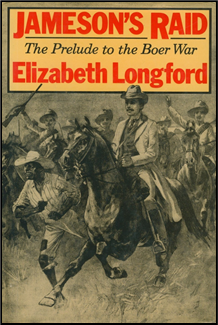 xxxxxAs we have seen, by the First Anglo-Boer War,
ending in 1881,
the Boer state of Transvaal regained its independence, lost in
1877. From the British point of view it was an humiliating defeat,
both from the political and military point of view. The liberal
government, led by prime minister William Gladstone, - a man
opposed to colonialism - was prepared to let matters rest,
but for many in high places and in the public at large, it was a
defeat that needed to be avenged.
xxxxxAs we have seen, by the First Anglo-Boer War,
ending in 1881,
the Boer state of Transvaal regained its independence, lost in
1877. From the British point of view it was an humiliating defeat,
both from the political and military point of view. The liberal
government, led by prime minister William Gladstone, - a man
opposed to colonialism - was prepared to let matters rest,
but for many in high places and in the public at large, it was a
defeat that needed to be avenged.
xxxxxThe
opportunity to do so came five years later when large gold
deposits were discovered in the Witwatersrand Basin and other
areas just south of modern-day Johannesburg. This brought a
large influx of fortune seekers into the Transvaal - many
from Britain - and this seriously undermined the stability of
the country. The Boers found themselves outnumbered two to one by
these Uitlanders (foreigners or outsiders) and they feared that
such a situation would provide yet another opportunity for the
British to seize control of the country. They had good cause for
such fears, particularly as London at that time was the capital of
the world’s gold trade, and these new deposits posed a serious
threat to the city’s financial status.
xxxxxTo meet
this crisis the Transvaal government imposed severe restrictions
upon the new comers. For the majority of them, the right to vote
and the right to obtain permanent residency were withheld, and the
income from this new, lucrative industry was heavily taxed. But
this policy only served to make matters worse. The new-comers
strongly objected to such treatment and opposition mounted. In the
gold-rush town of Johannesburg - where the Uitlanders
were in large numbers - there was open talk of insurrection,
and a plan was drawn up to seize the armoury at Pretoria. As we
have seen, for Cecil Rhodes, then governor of the Cape Colony,
this was an opportunity not to be missed. In mid-1895 he
conceived of a small private army, recruited by the British South
African Company, which, by marching on Johannesburg when the
rising took place - ostensibly to “restore order” -
would spark off a general uprising and bring about the overthrow
of the Transvaal government. That country and the Orange Free
State could then be formed into a federation under British
control, and his De Beers Mining Corporation would be free to take
over the gold mining industry based in Johannesburg.
xxxxxFor this
purpose an armed column, made up of some 600 men and reinforced by
a number of machine guns and some light artillery pieces, was
assembled in Rhodesia, the British colony to the north. Placed
under the command of Leander Starr Jameson, Cecil Rhodes’ right-hand
man, it was stationed at Pitsani on the Transvaal border, ready to
move once news of an uprising in Johannesburg had been received.
But Jameson waited in vain. A dispute had broken out between the
foreign workers in Johannesburg as to what form of administration
would replace the Boer government once it had been overthrown.
Eventually Jameson, growing impatient , decided to go ahead with
the proposed invasion, 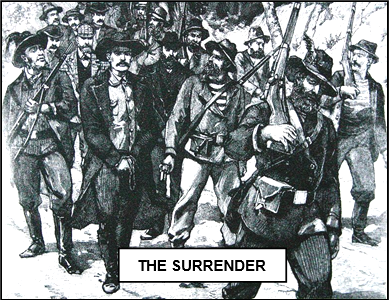 believing
that he could spearhead the insurrection on arriving at
Johannesburg. He sent a telegraph message to Rhodes telling him of
his intention and, receiving no immediate reply, cut the telegraph
lines on the morning of the 29th December 1895
and led his small army
into the Transvaal.
believing
that he could spearhead the insurrection on arriving at
Johannesburg. He sent a telegraph message to Rhodes telling him of
his intention and, receiving no immediate reply, cut the telegraph
lines on the morning of the 29th December 1895
and led his small army
into the Transvaal.
xxxThe
“Jameson Raid”, as it came to be called, was a complete failure. He
hoped to be in Johannesburg within three days, before the Boers had
had time to mobilise, but he failed to cut the telegraph line to
Pretoria, and, as a result, the Boers were able to keep track of the
invasion force from the moment it crossed the border. On the 1st
January 1896 Jameson found the road
blocked at Kurgersdopr and, following a brief skirmish, was forced
to make a diversion. Thexnext day he came
face to face with a large Boer force, equipped with artillery, at Doornkop, a ridge some 20 miles west of
Johannesburg. There was no possibility of success. After some hours
of resistance, he was forced to surrender and taken prisoner (illustrated).
xxxxxJameson was
imprisoned in Pretoria, and then returned to London for his trial.
At the end of February 1896 he was found guilty of leading the
raid and sentenced to 15 months in prison, but he was released in
December on health grounds. By way of compensation the Transvaal
government was paid a sum close to £1 million by the British South
Africa Company. Cecil Rhodes, the man who had planned the raid,
was forced to resign as prime minister of the Cape Colony and that
brought an end to his political career. The part played in the
affair by the British colonial secretary Joseph Chamberlain was
also questioned. He had known of the plan, but at his trial
Jameson did not implicate him, and he was subsequently cleared of
any wrong-doing by an investigation conducted by a select
committee of the House of Commons. In the Transvaal the leading
members of the Reform Committee, which had been scheming on behalf
of the Uitlander population, - including Colonel Frank Rhodes
(brother of Cecil Rhodes) - were charged and found guilty of
high treason for collaborating with Jameson. They were sentenced
to death in April, but released two months later on the payment of
heavy fines.
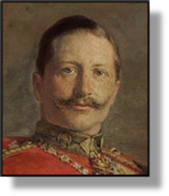
xxxxxIn Britain,
the outcome of the raid created a great deal of anti-Boer
feeling, and lit the fuse for the Second Anglo-Boer War.
Indeed, for many it was seen as a just cause for war. Jameson was
regarded as a hero, a brave upholder of the British Empire and the
rights of the individual. And there was, too, a great deal of
animosity towards Germany. After the surrender of Jameson’s
raiding party, the German Kaiser, Wilhelm II (illustrated), had sent a
message to Paul Kruger, the Transvaal prime minister, (the famous
“Kruger telegram”) congratulating him upon his victory. There was
talk of Germany providing the Boers with arms, and of the need for
Britain to reassert its authority before it was too late. Indeed,
the failure of the raid only served to highlight the fact that the
plight of the Uitlanders remained and had to be addressed.
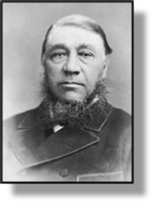
xxxxxAs we shall
see, after some unproductive negotiations, in September 1899 the
British government - clearly determined to regain control
over what was now a profitable area - delivered an ultimatum
to Paul Kruger (illustrated) demanding the immediate enfranchisement of all white
Uitlanders. There was no possibility of compliance, and the Second
Anglo-Boer War broke out in October 1899. It was to prove a long and bloody conflict, and one
which was to have important consequences for the future of South
Africa and the British Empire.
xxxxxIncidentally, British anger and fears concerning the “Kruger
Telegram” were well founded. As we shall see, following the
Jameson Raid, the Transvaal bought a great deal of military
equipment from Germany, and this served them well during the
Second Anglo-Boer War. And the Kaiser’s interest in south-east
Africa (Germany already had colonies in the west, south-west
and east of the continent) was followed in 1897 by the first of
Germany’s Naval Bills, clearly designed - as the War Office
saw it - to challenge Britain’s supremacy at sea. In a matter
of a few years, German ambition to play a part on the world stage
was to lead to British reconciliation with France and Russia, the
formation of two armed camps on the continent (The Triple Entente
and the Central Powers) and, eventually, the First World War of
1914 to 1918. ……
xxxxx…… The Jameson Raid had an indirect effect upon the
affairs of the neighbouring state of Rhodesia, the two territories
of Matabeleland and Mashonaland which were combined and named
after Cecil Rhodes in 1895. The withdrawal of the white police
force from this state to take part in the raid encouraged the
natives to take up arms against the British South Africa Company
and, as we shall see, this led to The Second Matabele War of 1896.
Vc-1881-1901-Vc-1881-1901-Vc-1881-1901-Vc-1881-1901-Vc-1881-1901-Vc-1881-1901-Vc
Including:
Leander Starr Jameson

xxxxxThe Scotsman
Leander Starr Jameson
(1853-1917) went to school in London and trained as a surgeon
at University College Hospital. He gained a reputation for his
work as a doctor, but, because of ill-health, in 1878 he went
out to Cape Colony in South Africa to benefit from a warmer
climate. There he struck up a close friendship with the diamond
magnate and politician Cecil Rhodes, and numbered among his
patients the statesman Paul Kruger and Lobengula, the King of the
Matabele. In order to assist Rhodes in his colonial ambitions and
his search for gold, in 1888 he persuaded Lobengula to grant
Rhodes mining rights in Mashonaland, a territory north of the
River Limpopo. In 1890, anxious like Rhodes to consolidate British
rule throughout South Africa, he abandoned his medical practice
and led a pioneer column to open the way to Mashonaland and claim
this area for the British South Africa Company. This alarmed
Lobengula. He invaded Mashonaland to prove his authority over the
region and, as we have seen, this caused the First Matabele War of
1893. Jameson
directed the campaign and the British force, small but well armed,
won the conflict. Matabeleland was then annexed for the British
crown. Jameson was now seen as a colonial statesmen of stature,
but then came the Jameson Raid of 1896, a foolhardy attempt, as we have seen, to invade the
Transvaal and trigger off a national uprising against the Boer
government. Its failure landed him in prison, but after his
release he returned to South African politics. He served as prime
minister for the Cape Colony from 1904 to 1908, assisted in the
formation of the Union of South Africa in 1910, and was then a
member of the Unionist Party for two years. Before returning home
he was created a baronet. Despite the debacle of the Jameson Raid,
he remained highly regarded for his patriotism, the quality of his
leadership, and his work in consolidating Britain’s hold over the
greater part of South Africa.
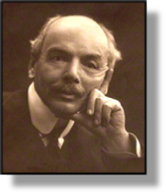 xxxxxLeander Starr Jameson (1853-1917)
was a doctor by profession (known to his close friends as “Doctor
Jim”), but later in life he became a colonial administrator and
statesmen in South Africa. He was born in Edinburgh, where his
father, Robert William Jameson - known for his reformist
ideas - was editor of the Wigtownshire Free Press. During his
early years the family moved to London, living in Chelsea and then
Kensington. He attended Godolphin School in Hammersmith, and then
trained as a surgeon at University College Hospital. After
qualifying he gained a reputation for his medical skill and his
lectures on anatomy, but he fell ill from over working and
eventually decided to settle in South Africa, where he hoped the
warmer climate would assist in his recovery.
xxxxxLeander Starr Jameson (1853-1917)
was a doctor by profession (known to his close friends as “Doctor
Jim”), but later in life he became a colonial administrator and
statesmen in South Africa. He was born in Edinburgh, where his
father, Robert William Jameson - known for his reformist
ideas - was editor of the Wigtownshire Free Press. During his
early years the family moved to London, living in Chelsea and then
Kensington. He attended Godolphin School in Hammersmith, and then
trained as a surgeon at University College Hospital. After
qualifying he gained a reputation for his medical skill and his
lectures on anatomy, but he fell ill from over working and
eventually decided to settle in South Africa, where he hoped the
warmer climate would assist in his recovery.
xxxxxHe set up a
practice at Kimberley in 1878, and it was not long before he came
to know the leading political figures in the Cape Colony. He
numbered among his patients Paul Kruger, the South African statesman, and the Matabale chief Lobengula
- who honoured him with the title
of InDuna, meaning Advisor - and
he struck up a close friendship with the politician and diamond
magnate Cecil Rhodes. It was in order to assist Rhodes in his
colonial and business ambitions that he persuaded Lobengula to
grant what came to be known as the Rudd Concession (Rudd being one
of Rhodes’ agents) in 1888. This simply allowed the British to
carry out mining operations on the land situated between the
Limpopo and Zambia Rivers. In return Rhodes provided the Matabele
chief with a monthly payment, a large number of rifles, and a
steamboat on the Zambesi.
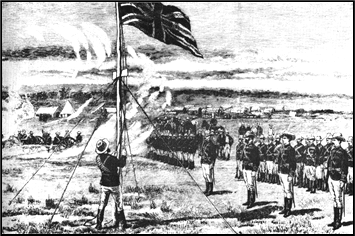 xxxxxIt was on the strength of this agreement -
reached in large measure by the good offices of Jameson -
that in 1889 Rhodes founded the British South Africa Company. The
following year, Rhodes having become prime minister of the Cape
Colony, Jameson decided to abandon his medical practice and
support Rhodes in his colonial ambitions. Like Rhodes, he was
anxious to consolidate British hold over the whole of South Africa
before others - be it the Germans, Portuguese or Boers -
seized valuable territory. He therefore agreed to take command of
a pioneer column made up of 180 volunteers and 200 armed police,
charged with the task of clearing a way through Matabeleland and
taking control of Mashonaland, an area thought to be rich in gold
deposits. Beginning in the July, the expedition made good progress
despite the difficult terrain through which it had to force a way
over a distance of some 425 miles. It entered Mashonaland, setting
up forts en route, and in September, having established Fort
Salisbury, raised the union jack (illustrated) and claimed the territory for the British crown -
in the guise of the British South Africa Company. In 1891 Jameson
was appointed administrator of Mashonaland, the traditional home of
the Shona people.
xxxxxIt was on the strength of this agreement -
reached in large measure by the good offices of Jameson -
that in 1889 Rhodes founded the British South Africa Company. The
following year, Rhodes having become prime minister of the Cape
Colony, Jameson decided to abandon his medical practice and
support Rhodes in his colonial ambitions. Like Rhodes, he was
anxious to consolidate British hold over the whole of South Africa
before others - be it the Germans, Portuguese or Boers -
seized valuable territory. He therefore agreed to take command of
a pioneer column made up of 180 volunteers and 200 armed police,
charged with the task of clearing a way through Matabeleland and
taking control of Mashonaland, an area thought to be rich in gold
deposits. Beginning in the July, the expedition made good progress
despite the difficult terrain through which it had to force a way
over a distance of some 425 miles. It entered Mashonaland, setting
up forts en route, and in September, having established Fort
Salisbury, raised the union jack (illustrated) and claimed the territory for the British crown -
in the guise of the British South Africa Company. In 1891 Jameson
was appointed administrator of Mashonaland, the traditional home of
the Shona people.
xxxxxBut the
activities of the Company, whilst in accordance with its charter -
granted by the British government - went far beyond the Rudd
Concession of 1888, and this alarmed Lobengula. In order to assert
his authority over Mashonaland - a tributary state - in
July 1893 he mounted an invasion of the territory to bring to heel
a dissident chief in the area of Victoria. This gave Jameson the
opportunity he was looking for to extend British control even
further. On the grounds that to take no action would undermine his
authority with the Mashona and he would lose their loyalty, he
ordered Lobengula to withdraw his troops and, when he refused to
do so, sought support for action from Rhodes and the home
government. Having received approval, he prepared an army to
invade Matebeleland.
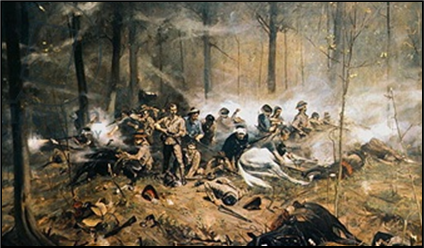
xxxxxAs we have
seen, the First Matabele War of 1893, in which Jameson assumed
direction of the campaign, gave the British total control over Matabeleland. The forces
of the British South Africa Company, though heavily outnumbered,
had a decisive advantage in firepower. Victory in the battles of
the Bembesi and Singuesi Rivers, achieved by the effectiveness of
the Maxim machine gun and the rapid-firing rifle, convinced
Lobengula that further resistance was futile. He fled with his
army into the bush after burning Bulawayo, his capital, to the
ground. Jameson, in order to bring the conflict to a speedy end,
ordered a march on Bulawayo and then, having learnt of the
whereabouts of Lobengula, sent out a column to capture the king.
This resulted in the loss of the Shangani Patrol in the December,
- when an advance guard of some 30 men was surrounded and
slaughtered (illustrated) - but in January 1894 Lobengula died, and the
Matabele (Ndebele) laid down their arms.
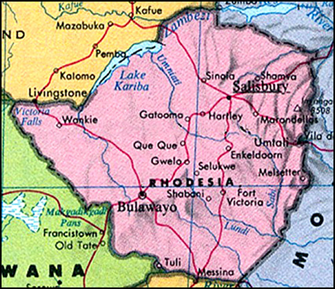 xxxxxFollowing the death of
Lobengula, Jameson was appointed the first administrator of
Matabeleland and, on returning to Britain at the end of the year,
along with Rhodes, was feted as a hero. On his return to South
Africa in the spring of 1895, the two territories of Matabeleland
and Mashonaland were officially named Rhodesia in honour of the
architect of British imperialism.
xxxxxFollowing the death of
Lobengula, Jameson was appointed the first administrator of
Matabeleland and, on returning to Britain at the end of the year,
along with Rhodes, was feted as a hero. On his return to South
Africa in the spring of 1895, the two territories of Matabeleland
and Mashonaland were officially named Rhodesia in honour of the
architect of British imperialism.
xxxxxBut
Jameson’s reputation as a colonial diplomat, though not
irreparably damaged, received a severe blow, as we have seen, with
the infamous Jameson Raid, defeated in 1896. It was originally intended to be made in support of
a revolt among the discontented Uitlanders of Johannesburg -
those foreigners (or outsiders) who had flooded into the Transvaal
in search of gold - and thereby trigger off a general
uprising against the Boer government. But despite the fact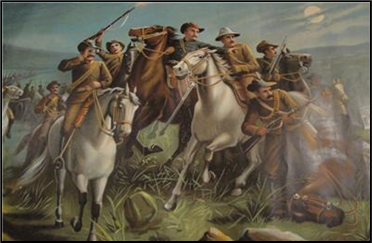 that no revolt took place in the city, Jameson nonetheless
launched the invasion in December 1895. It was, as it proved to
be, a foolhardy miscalculation on his part. The armed column, made
up of some 600 men and supported with only a small amount of light
artillery, was harassed from the time it crossed the border, and
forced to accept a humiliating defeat at Doornkop five days later
on the 2nd January 1896. Jameson was
captured, sent to England for trial, and sentenced to fifteen
months imprisonment, though he was released earlier due to ill-health.
that no revolt took place in the city, Jameson nonetheless
launched the invasion in December 1895. It was, as it proved to
be, a foolhardy miscalculation on his part. The armed column, made
up of some 600 men and supported with only a small amount of light
artillery, was harassed from the time it crossed the border, and
forced to accept a humiliating defeat at Doornkop five days later
on the 2nd January 1896. Jameson was
captured, sent to England for trial, and sentenced to fifteen
months imprisonment, though he was released earlier due to ill-health.
xxxxxThis
debacle resulted in deep embarrassment for the British government,
particularly as it was alleged that the Colonial Secretary had
known and approved of the raid, and it also soured relations with
Germany following the famous “Kruger telegram”, but nonetheless
the conduct of Jameson during his trial won him a great deal of
support. He stoically accepted blame for the raid, implicated no
others, and won approval for what the public saw as his commitment
- be it over zealous - to the well being of the
Uitlanders (many of them British) who were denied their basic
rights by the Transvaal government. Indeed, as we shall see, it
was the continued plight of the Uitlanders which was to bring
about The Second Anglo-Boer War of 1899.
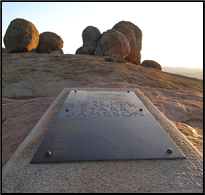 xxxxxJameson took no part in this second conflict with the
Boers, but on his return to South Africa he became leader of the
Progressive Party in Cape Colony in 1903 and, following the
party’s success at the polls, served as prime minister from 1904
to 1908. After the founding of the Union of South Africa (The
Cape, Natal, Transvaal and Orange Free State) in which he played a
part, he was a member of the Unionist Party from 1910 to 1912, and
before returning home was created a baronet. He died in London in
November 1917 and was buried in a vault at Kensal Green cemetery,
but after the end of the First World War his body was taken to
South Africa and buried at Malindidzimu Hill (World’s View) in
Matabo National Park, some 25 miles south of Bulawayo, alongside
the grave of his close friend Cecil Rhodes. This granite hill was
designated by Rhodes as a resting place for those who had served
Great Britain well in Africa.
xxxxxJameson took no part in this second conflict with the
Boers, but on his return to South Africa he became leader of the
Progressive Party in Cape Colony in 1903 and, following the
party’s success at the polls, served as prime minister from 1904
to 1908. After the founding of the Union of South Africa (The
Cape, Natal, Transvaal and Orange Free State) in which he played a
part, he was a member of the Unionist Party from 1910 to 1912, and
before returning home was created a baronet. He died in London in
November 1917 and was buried in a vault at Kensal Green cemetery,
but after the end of the First World War his body was taken to
South Africa and buried at Malindidzimu Hill (World’s View) in
Matabo National Park, some 25 miles south of Bulawayo, alongside
the grave of his close friend Cecil Rhodes. This granite hill was
designated by Rhodes as a resting place for those who had served
Great Britain well in Africa.
 xxxxxIncidentally, the British
writer and poet Rudyard Kipling, himself a fervent patriot and
imperialist, was a great admirer of Jameson and got to know him on
his visits to South Africa. He applauded his personal qualities,
such as his courage, dignity, and stoicism, and let it be known
that his famous poem If “was drawn
from Jameson’s character”. The line: If you can
keep your head when all about you are losing theirs and blaming
it on you, aptly sums up the way Jameson handled the
furore which followed the Jameson Raid, a disaster of his own
making. ……
xxxxxIncidentally, the British
writer and poet Rudyard Kipling, himself a fervent patriot and
imperialist, was a great admirer of Jameson and got to know him on
his visits to South Africa. He applauded his personal qualities,
such as his courage, dignity, and stoicism, and let it be known
that his famous poem If “was drawn
from Jameson’s character”. The line: If you can
keep your head when all about you are losing theirs and blaming
it on you, aptly sums up the way Jameson handled the
furore which followed the Jameson Raid, a disaster of his own
making. ……
xxxxx…… According to some accounts, after the Jameson Raid
it was the wealthy diamond trader Barney Barnato who negotiated
with his friend Paul Kruger, the Boer president, and managed to
get all his pals released from prison and sent to England for
their trial. ……
xxxxx…… Jameson’s unusual first names came about from an
incident which occurred on the morning of his birth. His father
was walking along a stretch of canal or river on the day his
twelfth child was due to be born when he slipped and fell into the
water. A passer-by, an American traveller named Leander
Starr, fished him out and, to show his gratitude, his father named
his new son after him!






 xxxxxAs we have seen, by the First Anglo-
xxxxxAs we have seen, by the First Anglo- believing
that he could spearhead the insurrection on arriving at
Johannesburg. He sent a telegraph message to Rhodes telling him of
his intention and, receiving no immediate reply, cut the telegraph
lines on the morning of the 29th December 1895
and led his small army
into the Transvaal.
believing
that he could spearhead the insurrection on arriving at
Johannesburg. He sent a telegraph message to Rhodes telling him of
his intention and, receiving no immediate reply, cut the telegraph
lines on the morning of the 29th December 1895
and led his small army
into the Transvaal.


 xxxxxLeander Starr Jameson (1853-
xxxxxLeander Starr Jameson (1853- xxxxxIt was on the strength of this agreement -
xxxxxIt was on the strength of this agreement -
 xxxxxFollowing the death of
Lobengula, Jameson was appointed the first administrator of
Matabeleland and, on returning to Britain at the end of the year,
along with Rhodes, was feted as a hero. On his return to South
Africa in the spring of 1895, the two territories of Matabeleland
and Mashonaland were officially named Rhodesia in honour of the
architect of British imperialism.
xxxxxFollowing the death of
Lobengula, Jameson was appointed the first administrator of
Matabeleland and, on returning to Britain at the end of the year,
along with Rhodes, was feted as a hero. On his return to South
Africa in the spring of 1895, the two territories of Matabeleland
and Mashonaland were officially named Rhodesia in honour of the
architect of British imperialism.  that no revolt took place in the city, Jameson nonetheless
launched the invasion in December 1895. It was, as it proved to
be, a foolhardy miscalculation on his part. The armed column, made
up of some 600 men and supported with only a small amount of light
artillery, was harassed from the time it crossed the border, and
forced to accept a humiliating defeat at Doornkop five days later
on the 2nd January 1896. Jameson was
captured, sent to England for trial, and sentenced to fifteen
months imprisonment, though he was released earlier due to ill-
that no revolt took place in the city, Jameson nonetheless
launched the invasion in December 1895. It was, as it proved to
be, a foolhardy miscalculation on his part. The armed column, made
up of some 600 men and supported with only a small amount of light
artillery, was harassed from the time it crossed the border, and
forced to accept a humiliating defeat at Doornkop five days later
on the 2nd January 1896. Jameson was
captured, sent to England for trial, and sentenced to fifteen
months imprisonment, though he was released earlier due to ill- xxxxxJameson took no part in this second conflict with the
Boers, but on his return to South Africa he became leader of the
Progressive Party in Cape Colony in 1903 and, following the
party’s success at the polls, served as prime minister from 1904
to 1908. After the founding of the Union of South Africa (The
Cape, Natal, Transvaal and Orange Free State) in which he played a
part, he was a member of the Unionist Party from 1910 to 1912, and
before returning home was created a baronet. He died in London in
November 1917 and was buried in a vault at Kensal Green cemetery,
but after the end of the First World War his body was taken to
South Africa and buried at Malindidzimu Hill (World’s View) in
Matabo National Park, some 25 miles south of Bulawayo, alongside
the grave of his close friend Cecil Rhodes. This granite hill was
designated by Rhodes as a resting place for those who had served
Great Britain well in Africa.
xxxxxJameson took no part in this second conflict with the
Boers, but on his return to South Africa he became leader of the
Progressive Party in Cape Colony in 1903 and, following the
party’s success at the polls, served as prime minister from 1904
to 1908. After the founding of the Union of South Africa (The
Cape, Natal, Transvaal and Orange Free State) in which he played a
part, he was a member of the Unionist Party from 1910 to 1912, and
before returning home was created a baronet. He died in London in
November 1917 and was buried in a vault at Kensal Green cemetery,
but after the end of the First World War his body was taken to
South Africa and buried at Malindidzimu Hill (World’s View) in
Matabo National Park, some 25 miles south of Bulawayo, alongside
the grave of his close friend Cecil Rhodes. This granite hill was
designated by Rhodes as a resting place for those who had served
Great Britain well in Africa. xxxxxIncidentally, the British
writer and poet Rudyard Kipling, himself a fervent patriot and
imperialist, was a great admirer of Jameson and got to know him on
his visits to South Africa. He applauded his personal qualities,
such as his courage, dignity, and stoicism, and let it be known
that his famous poem If “was drawn
from Jameson’s character”. The line: If you can
keep your head when all about you are losing theirs and blaming
it on you, aptly sums up the way Jameson handled the
furore which followed the Jameson Raid, a disaster of his own
making. ……
xxxxxIncidentally, the British
writer and poet Rudyard Kipling, himself a fervent patriot and
imperialist, was a great admirer of Jameson and got to know him on
his visits to South Africa. He applauded his personal qualities,
such as his courage, dignity, and stoicism, and let it be known
that his famous poem If “was drawn
from Jameson’s character”. The line: If you can
keep your head when all about you are losing theirs and blaming
it on you, aptly sums up the way Jameson handled the
furore which followed the Jameson Raid, a disaster of his own
making. ……

